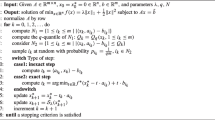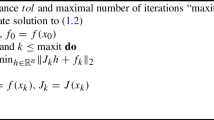Abstract
Square-root unscented Kalman filter (SRUKF) is a widely used state estimator for several state of-the-art, highly nonlinear, and critical applications. It improves the stability and numerical accuracy of the system compared to the non-square root formulation, the unscented Kalman filter (UKF). At the same time, SRUKF is less computationally intensive compared to UKF, making it suitable for portable and battery-powered applications. This paper proposes a low-complexity and power-efficient architecture design methodology for SRUKF presented with a use case of the simultaneous localization and mapping (SLAM) problem. Implementation results show that the proposed SRUKF methodology is highly stable and achieves higher accuracy than the extensively used extended Kalman filter and UKF when developed for highly critical nonlinear applications such as SLAM. The design is synthesized and implemented on resource constraint Zynq-7000 XC7Z020 FPGA-based Zedboard development kit and compared with the state-of-the-art Kalman filter-based FPGA designs. Synthesis results show that the architecture is highly stable and has significant computation savings in DSP cores and clock cycles. The power consumption was reduced by 64\(\%\) compared to the state-of-the-art UKF design methodology. ASIC design was synthesized using UMC 90-nm technology, and the results for on-chip area and power consumption results have been discussed.










Similar content being viewed by others
Data Availability
Data sharing is not applicable to this article as no datasets were generated or analyzed during the present study.
References
A. Acharyya, K. Maharatna, B.M. Al-Hashimi, Hardware reduction methodology for 2-dimensional kurtotic fastica based on algorithmic analysis and architectural symmetry, in Proc. IEEE Workshop Signal Processing Systems (2009). pp. 069–074
A. Acharyya, K. Maharatna, B.M. Al-Hashimi, Algorithm and architecture for N-D vector cross-product computation. IEEE Trans. Signal Process. 59(2), 812–826 (2011)
B. Adapa, D. Biswas, S. Bhardwaj, R. Raghuraman, A. Acharyya, Coordinate rotation-based low complexity \(K\) -Means clustering architecture. IEEE Trans. Very Large Scale Integr. VLSI Syst. 25(4), 1568–1572 (2017). https://doi.org/10.1109/TVLSI.2016.2633543
A. Andrew, A square root formulation of the Kalman covariance equations. AIAA J. 6, 1165–1166 (1968)
T. Bailey, H. Durrant-Whyte, Simultaneous localization and mapping (SLAM): part II. IEEE Robot. Autom. Magaz. 13(3), 108–117 (2006)
S. Bhardwaj, S. Raghuraman, A. Acharyya, Simplex FastICA: an accelerated and low complex architecture design methodology for \(n\) D FastICA. IEEE Trans. Very Large Scale Integr. VLSI Syst. 27(5), 1124–1137 (2019). https://doi.org/10.1109/TVLSI.2018.2886357
A.W. Bojanczyk, A.O. Steinhardt, Stability analysis of a Householder-based algorithm for downdating the Cholesky factorization. SIAM J. Sci. Stat. Comput. 12(5), 1255–65 (1991)
R. Chávez-Bracamontes, M.A. Gurrola-Navarro, H.J. Jiménez-Flores, M. Bandala-Sánchez, VLSI architecture of a Kalman filter optimized for real-time applications. IEICE Electron. Exp. 13(6), 2016004320160043 (2016)
S.I. Chou, C.M. Rader, Algorithm-based error detection of a cholesky factor updating systolic array using CORDIC processors, in Proc. SPIE Vol. 977 Real Time Signal Processing XI (1988). pp. 104–111
L. Contreras, S. Cruz, J.M.S.T. Motta, C.H. Llanos, Hardware and software codesign for the EKF applied to the mobile robotics localization problem. Int. J. Mach. Learn. Comput. 5(2), 101 (2015)
J. Crassidis, F. Markley, Y. Cheng, Survey of nonlinear attitude estimation methods. J. Guid. Control. Dyn. 30(1), 12–28 (2007)
S. Cruz, D.M. Munóz, M. Conde, C.H. Llanos, G.A. Borges, FPGA implementation of a sequential Extended Kalman Filter algorithm applied to mobile robotics localization problem, in IEEE 4th Latin American Symposium on Circuits and Systems (LASCAS), Cusco (2013). pp. 1–4
J.M. Delosme, S.F. Hsiao, CORDIC algorithms in four dimensions, Advanced Algorithms and Architectures for Signal Processing IV Proc. SPIE 1348, 349–360 (1990)
J.M. Delosme, CORDIC algorithms: theory and extensions, in Proc. SPIE Advanced Algorithms and Architectures for Signal Processing IV, vol. 1152 (1989)
H. Durrant-Whyte, T. Bailey, Simultaneous localization and mapping: part I. IEEE Robot. Autom. Magaz. 13(2), 99–110 (2006)
R. Dutt, A. Acharyya, A high speed and low complexity architecture design methodology for square root unscented Kalman Filter based SLAM, in European Conference on Circuit Theory and Design (ECCTD), Sofia, Bulgaria (2020). pp. 1-4. https://doi.org/10.1109/ECCTD49232.2020.9218287
A. Evangelidis, D. Parker, Quantitative verification of numerical stability for Kalman filters, in International Symposium on Formal Methods (Springer, Cham, 2019). pp. 425–441
Á.F. Garcia-Fernandez, M.R. Morelande, J. Grajal, Multitarget simultaneous localization and mapping of a sensor network. IEEE Trans. Signal Process. 59(10), 4544–4558 (2011). https://doi.org/10.1109/TSP.2011.2160862
G.H. Golub, C.F. Van Loan, Matrix Computations, 3rd edn. (The Johns Hopkins Univ. Press, Baltimore, MD, 1996)
J.E. Guivant, E.M. Nebot, Optimization of the simultaneous localization and map-building algorithm for real-time implementation. IEEE Trans. Robot. Autom. 17(3), 242–257 (2001). https://doi.org/10.1109/70.938382
F. Gustafsson, Particle filter theory and practice with positioning applications. IEEE Aerosp. Electron. Syst. Mag. 25(7), 53–82 (2010). https://doi.org/10.1109/MAES.2010.5546308
F. Gustafsson, G. Hendeby, Some Relations Between Extended and Unscented Kalman Filters. IEEE Trans. Signal Process. 60(2), 545–555 (2012). https://doi.org/10.1109/TSP.2011.2172431
S. Holmes, G. Klein, D.W. Murray, A square root unscented Kalman Filter for visual monoSLAM, in IEEE International Conference on Robotics and Automation (Pasadena, CA, 2008). pp. 3710–3716
S. Holmes, G. Klein, D.W. Murray, An O(\(\text{ N}^2\)) square root unscented Kalman filter for visual simultaneous localization and mapping. IEEE Trans. Pattern Anal. Mach. Intell. 31(7), 1251–1263 (2009)
S.F. Hsiao, J.M. Delosme, Householder CORDIC algorithms. IEEE Trans. Comput. 44(8), 990–1001 (1995)
G.P. Huang, A.I. Mourikis, S.I. Roumeliotis, A quadratic-complexity observability-constrained unscented Kalman filter for SLAM. IEEE Trans. Rob. 29(5), 1226–1243 (2013)
R. Inan, M. Barut, F. Karakaya, FPGA implementation of Extended Kalman Filter for speed-sensorless control of induction motors, in 7th IET International Conference on Power Electronics, Machines and Drives (PEMD) (2014). pp. 1–6
X. Jiang, T. Li, Y. Yu, A novel SLAM algorithm with Adaptive Kalman filter, in International Conference on Advanced Robotics and Mechatronics (ICARM) (Macau, China, 2016). pp. 107–111. https://doi.org/10.1109/ICARM.2016.7606903
S. Julier, J. Uhlmann, A counter example to the theory of simultaneous localization and map building, in Proc. IEEE Int. Conf. Robot. Autom. (Seoul, Korea, 2001). pp. 4238–4243
S.J. Julier, The spherical simplex unscented transformation. Proc. Amer. Control Conf. 3, 2430–2434 (2003)
S.J. Julier, J.K. Uhlmann, Unscented filtering and nonlinear estimation. Proc. IEEE 92(3), 401–422 (2004)
S. Julier, J. Uhlmann, H.F. Durrant-Whyte, A new method for the nonlinear transformation of means and covariances in filters and estimators. IEEE Trans. Autom. Control 45(3), 477–482 (2000)
R.E. Kalman, A new approach to linear filtering and prediction problems. Trans. ASME-J. Basic Eng. 82(1), 35–45 (1960)
P. Kaminski, A. Bryson, S. Schmidt, Discrete square root filtering: a survey of current techniques. IEEE Trans. Autom. Control 16(6), 727–736 (1971)
D. Kotzor, W. Utschick, Kernel methods for ill-Posed Range-Based localization problems. IEEE Trans. Signal Process. 60(8), 4151–4162 (2012). https://doi.org/10.1109/TSP.2012.2199313
I.H. Kurniawan, J. Yoon, J. Park, Multidimensional Householder based high-speed QR decomposition architecture for MIMO receivers, in IEEE International Symposium on Circuits and Systems (ISCAS) (Beijing, 2013). pp. 2159–2162
Z. Kurt-Yavuz, S. Yavuz, A comparison of EKF, UKF, FastSLAM2.0, and UKF-based FastSLAM algorithms, in IEEE 16th International Conference on Intelligent Engineering Systems (INES) (Lisbon, 2012). pp. 37–43
S. Lee, J. McBride, Extended object tracking via positive and negative information fusion. IEEE Trans. Signal Process. 67(7), 1812–1823 (2019). https://doi.org/10.1109/TSP.2019.2897942
F.L. Lewis, Optimal Estimation: With an Introduction to Stochastic Control Theory (John Wiley and Sons, New York, USA, 1986)
S. Li, P. Ni, Square-root unscented Kalman filter based simultaneous localization and mapping, in EEE International Conference on Information and Automation (Harbin, 2010). pp. 2384–2388
S.A. Li, C. Li, FPGA implementation of adaptive Kalman filter for industrial ultrasonic applications, Microsystem Technologies (2019)
T. Li, A. Ekpenyong, Y. Huang, Source localization and tracking using distributed asynchronous sensors. IEEE Trans. Signal Process. 54(10), 3991–4003 (2006). https://doi.org/10.1109/TSP.2006.880213
J. Liao et al., FPGA implementation of a Kalman-based motion estimator for levitated nanoparticles. IEEE Trans. Instrum. Meas. 68(7), 2374–2386 (2018)
R. Martinez-Cantin, J.A. Castellanos, Unscented SLAM for large-scale outdoor environments, in IEEE/RSJ International Conference on Intelligent Robots and Systems (2005)
S. Mopuri, A. Acharyya, Low-Complexity and high-speed architecture design methodology for complex square root. Circuits Syst. Signal Process. 40(11), 5759–5772 (2021)
M. Morf, T. Kailath, Square-root algorithms for least squares estimation. IEEE Trans. Autom. Control 20(4), 487–497 (1975)
M. Nørgaard, N.K. Poulsen, O. Ravn, New developments in state estimation for nonlinear systems. Automatica 36(11), 1627–1638 (2000)
P.T. Pereira, G. Paim, Pu. Da Costa, E.A. Da Costa, S.J. De Almeida, S. Bampi, Architectural exploration for energy-Efficient fixed-Point Kalman Filter VLSI design. IEEE Trans. Very Large Scale Integr. VLSI Syst. 29(7), 1402–1415 (2021). https://doi.org/10.1109/TVLSI.2021.3075379
J.E. Potter, R.G. Stern, Statistical filtering of space navigation measurements, in Proceedings of the AIAA Guidance Control Conference (1963)
W.H. Press, S.A. Teukolsky, W.T. Vetterling, B.P. Flannery, Numerical Recipes in C : The Art of Scientific Computing, 2nd edn. (Cambridge University Press, UK, 1992)
M. Rhudy, Y. Gu, M.R. Napolitano, An analytical approach for comparing linearization methods in EKF and UKF. Int. J. Adva. Robot. Syst. 10, 208 (2013)
M. Seeger, Low Rank Updates for the Cholesky Decomposition (2004)
J. Soh, X. Wu, A modular FPGA-based implementation of the unscented Kalman filter, in Proc. IEEE NASA/ESA Conf. AHS, (2014). pp. 127-134
J. Soh, X. Wu, An FPGA-Based Unscented Kalman Filter for System-On-Chip Applications. IEEE Trans. Circuits Syst. II Express Briefs 64(4), 447–451 (2017)
J. Solà, T. Vidal-Calleja, J. Civera et al., Impact of landmark parametrization on monocular EKF-SLAM with points and lines. Int. J. Comput. Vision 97, 339–368 (2012)
R. van der Merwe, E.A. Wan, The square-root unscented Kalman filter for state and parameter-estimation, in IEEE International Conference on Acoustics, Speech, and Signal Processing. Proceedings (Cat. No.01CH37221) vol.6, (2001). pp. 3461–3464. https://doi.org/10.1109/ICASSP.2001.940586
M. Verhaegen, P. van Dooren, Numerical aspects of different Kalman filter implementations. IEEE Trans. Autom. Control 31(10), 907–917 (1986)
E.A. Wan, R. van der Merwe, The unscented Kalman filter for nonlinear estimation, in Proceedings of the IEEE 2000 Adaptive Systems for Signal Processing, Communications, and Control Symposium (Cat. No.00EX373) (2000). pp. 153–158. https://doi.org/10.1109/ASSPCC.2000.882463
J.H. Wilkinson, Global convergence of tridiagonal QR algorithm with origin shifts. Linear Algebra Appl. 1, 409–420 (1968)
F.F. Yadkuri, M.J. Khosrowjerdi, Methods for improving the linearization problem of Extended Kalman Filter. J. Intell. Robot. Syst. 78(3–4), 485–497 (2015)
Acknowledgements
The authors acknowledge the Intel India Research Fellowship - 2020 for supporting the project. The authors would also like to acknowledge the support extended by the Defence Research and Development Organisation (DRDO), Ministry of Defence, Government of India.
Author information
Authors and Affiliations
Corresponding author
Additional information
Publisher's Note
Springer Nature remains neutral with regard to jurisdictional claims in published maps and institutional affiliations.
Rights and permissions
Springer Nature or its licensor (e.g. a society or other partner) holds exclusive rights to this article under a publishing agreement with the author(s) or other rightsholder(s); author self-archiving of the accepted manuscript version of this article is solely governed by the terms of such publishing agreement and applicable law.
About this article
Cite this article
Dutt, R., Acharyya, A. Low-Complexity Square-Root Unscented Kalman Filter Design Methodology. Circuits Syst Signal Process 42, 6900–6928 (2023). https://doi.org/10.1007/s00034-023-02437-9
Received:
Revised:
Accepted:
Published:
Issue Date:
DOI: https://doi.org/10.1007/s00034-023-02437-9




